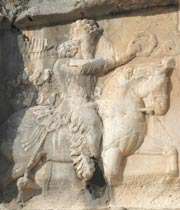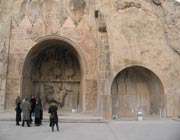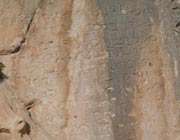Bishapour
(A City in the Heart of History)
The ruins of the historical city of Bishapour are found on the slope of Koohmareh heights, 23 Kilometers west of the city of Kazeroon.
Bishapour was built on the side of the ancient Imperial Road which was once one of the country's most strategic roads.
During the Achaemenian period, the Imperial Road connected Takht-e-Jamshid and Estakhr to the ancient city of Shush. During the Sassanid period this road connected Firoozabad and Bishapour cities to Tisfoon, which was the then capital of the Sassanid dynasty.
In addition to enjoying military and strategic significance, this road was also an important trade route. The city was later called Antiuk Shapour, meaning more beautiful than Antakieh, in Asia Minor, and this was due to its location in the beautiful Shapour plain, in the green and narcissus- filled Karen plain with the Cheshmeh Sasan River crossing it. In addition to all these natural features, the city's architecture borrowed designs and motifs from other civilizations of that era. Bishapour easily competed with the most beautiful and richest cities of the then civilized world like Antakieh (Antioch), the bride of all cities in Byzantium.

The people came to tour Bishapour from different corners of the country. The city planning and architectural patterns in Bishapour, which were some of the most wonderful architectural phenomena of the time, remained unknown till the present time. There is no evidence to point our to any fundamental changes in city planning during the Partian period prior to the construction of Bishapour. The Darab Gard and Ardeshir Khoreh had been built on the basis of the Parthians traditional architecture. However, a prevalent cultural movement in then Bishapour concentrated on the revival and maintenance of the National Persian traditions which had deep roots in that land.

Archaeological documents and scientific research, plus the works discovered in this city, all speak of the same reality and we can observe how the city planning changed on the basis of political initiatives, new governments were established, the economy flourished and a firm social order emerged, since during those days the city was the center of the ruling party where state directives and decrees were issued.
Such cities were by no means mere residential areas. The design of the city is not circular. Streets and roads cross each other in the center. These streets and parks and other recreational centers, lush areas, and special complexes produced a beautiful checkered design which contributed to the residents tranquility.
The state buildings were constructed in the center of the old castle, north of the city, which was the best choice for this purpose. Each building in this complex had its own specifications and peculiarities. Here unlike the Partian era, the facade did not manifest the glory of the building and instead large halls with vaults and a variety of colorful and ornamented designs plus brick tiles on the floor, which were unprecedented up to that date, had been adopted from the capital of Byzantium in the Antakieh style of architecture. Application of stucco and colorful paintings inside the vaults and under the ceilings all spoke of a new design in Bishapour.

Due to incomplete excavation, there is no completed knowledge about the city structure, however studies of the monuments discovered so far like the city castle tower and rampart, reception halls, porches carpeted with brick tiles in the eastern and western sides of the hall, as well as the buildings, in the unique Anahita temple, all indicate that at the beginning, the Sassanid culture and civilization had been affected by its past and pursued the art work of the Achaemenian period. Though the Sassanids failed to reach and enjoy high levels of technical expertise in city planning, in stonework however, especially in producing embossed three-dimensional shapes, they could well compete against their predecessor, Achaemenids, and adopted their style.
Stonework
Examples of sophisticated stonework can be seen in Tang-e-Chogan located in the northern section of the city. Utilizing decorative designs art and motifs of other civilizations, like those of eastern Rome, a combined Iranian style was produced which was influenced by the older Iranian style and that of the West. And in this manner, the artists of the time initiated new styles and this was a revival of traditional Iranian architecture and a new page in the history of Iranian city planning and architecture.
Dabir was the designer and architect of Espai city whose name was mentioned in the Persian manuscript of the city during the Partian and the Sassanid periods. The gigantic reception hall of Shapour Palace which was built in the southeastern section of Anahita temple, and occupies about 781 square meters, is one of the earliest and biggest dome-shaped architectural works during the Sassanid period.
Bishapour's reception hall is composed of four parallel and connected porches under a 25 meter high dome.
Buildings
The building itself is built in the shape of a cross with total of 64 decorative niches. Two porches carpeted with tiles are connected to the reception hall whose discovery is proof of the technical skills applied there with a combination of the motifs borrowed from Western architectural styles. There are very beautiful paintings and stucco works in the palace which reflect the talent and taste of the builders. In the great Anahita temple, the goddess of water is another wonder that has been discovered in Bishapour. This great cellar- like building is cube-shaped and has 14-meter-long double-layer stone walls.
No mortar has applied in these walls. The width of these double layer walls is about 235 centimeters. On the building's northern side can be seen four stone cow sculptures of the Achaemenian era. These sculptures have been installed two by two, facing each other. A couple of these sculptures still exist on the northern side of the palace as exclusive symbols of the temple.
On the sides of the southern hall there are two doorways, one overlooks the western hall and the other overlooks the eastern hall, exclusively built for people to observe the flow of water. To construct such a great hall for worship, an area with dimensions measuring 27x23x7 cubic meters was dug in the depth of the ground, designed in a manner to let a branch of Shapour River, 250 meters away from the temple, flow into it.
Water distribution
The water distributing canals had been precisely designed and built to facilitate the flow of equal amounts of water in each of the waterways. The great Bishapour temple, which was unearthed following scientific studies and archaeological excavations, is the symbol of a place designed to worship and admire water. It is the most clear manifestation of the belief during Shapour the Babakan, where the flow of water is mixed with a sense of respect. This has been a place for the admiration of water, one of the four basic elements attributed to Nahid, the goddess and guardian of water.
Source: iranchamber.com
Other Links:
Esfahan
Bridges of Isfahan
Esfahan or Half the world